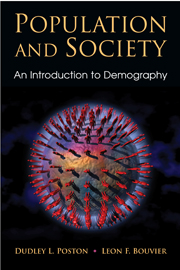Book contents
- Frontmatter
- Contents
- Preface
- Introduction
- 1 “We Are All Population Actors”: An Introduction to Demography
- 2 The Sources of Demographic Information
- 3 Fertility
- 4 Contraception and Birth Control
- 5 Mortality
- 6 Internal Migration
- 7 International Migration
- 8 Age and Sex Composition
- 9 World Population Change over Time
- 10 Population Change in the United States
- 11 Population Distribution
- 12 Cultural Adaptation and Growth
- 13 Population Policy
- 14 The Future of Planet Earth
- Glossary
- References
- Author Index
- Subject Index
13 - Population Policy
- Frontmatter
- Contents
- Preface
- Introduction
- 1 “We Are All Population Actors”: An Introduction to Demography
- 2 The Sources of Demographic Information
- 3 Fertility
- 4 Contraception and Birth Control
- 5 Mortality
- 6 Internal Migration
- 7 International Migration
- 8 Age and Sex Composition
- 9 World Population Change over Time
- 10 Population Change in the United States
- 11 Population Distribution
- 12 Cultural Adaptation and Growth
- 13 Population Policy
- 14 The Future of Planet Earth
- Glossary
- References
- Author Index
- Subject Index
Summary
INTRODUCTION
A population policy is a deliberately constructed arrangement or program “through which governments influence, directly or indirectly, demographic change” (Demeny, 2003: 752). These arrangements typically are “legislative measures, administrative programs, and other governmental actions intended to alter or modify existing population trends in the interest of national survival and welfare” (Eldridge, 1968: 381). The demographer John May has written that “population policies are designed to regulate and, if possible, mitigate the problems [of too rapid growth or decline] by adjusting population size and structure to the needs and aspirations of the people” (2005: 828).
Population policies are usually understood to represent strategies for governments or sometimes, albeit less frequently, nongovernmental organizations (NGOs) to attain specific goals. The procedures or programs are put into place to ensure that the goals of the policy are attained. As already noted, a policy is generally intended to either reduce or increase population levels. Policies are typically developed “in the interest of the greater good…in order to address imbalances between demographic changes and other social, economic and political goals” (May, 2005: 828).
We read in earlier chapters of this book that many countries in the world today have high rates of population growth. We also know that many have negative or near-negative rates of growth, and many more have fertility rates below replacement levels. In 2008, for instance, more than seventy countries had total fertility rates below 2.1 (Population Reference Bureau, 2008b).
- Type
- Chapter
- Information
- Population and SocietyAn Introduction to Demography, pp. 338 - 366Publisher: Cambridge University PressPrint publication year: 2010



